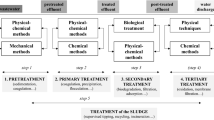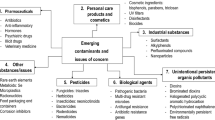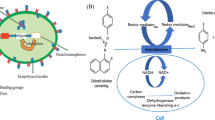Abstract
Advanced oxidation processes (AOPs) are based on the in situ production of hydroxyl radicals (•OH) and reactive oxygen species (ROS) in water upon irradiation of the sample by UV light, ultrasound, electromagnetic radiation, and/or the addition of ozone or a semiconductor. Diclofenac (DCF), one of the emerging organic contaminants (EOC), is of environmental concern due to its abundancy in water and is known to be subjected to AOPs. The current study uses density functional theory (DFT) to elucidate the mechanisms of the reactions between •OH and DCF leading to degradation by-products, P1-P9. The initial encounter of DCF with •OH is proposed to lead to either the abstraction of a hydrogen or the addition of the hydroxyl radical to the molecule. The results showed that OH addition radicals (R add) are both kinetically and thermodynamically favored over H abstraction radicals (R abs). The intermediate radicals give degradation by-products by subsequent reactions. The by-products P7 and P8 are easily formed in agreement with experimental findings. Finally, acute toxicities at three trophic levels are estimated with the Ecological Structure Activity Relationships program. DCF and most of the by-products were found to be harmful to aquatic organisms, P9 being the only by-product that is not harmful at all three trophic levels.






Similar content being viewed by others
References
Adamo C, Barone V (1998) Exchange functionals with improved long-range behavior and adiabatic connection methods without adjustable parameters: the mPW and mPW1PW models. J Chem Phys 108:664–675. doi:10.1063/1.475428
An T, Gao Y, Li G, Kamat PV, Peller J, Joyce MV (2014) Kinetics and mechanism of (OH)-O-center dot mediated degradation of dimethyl phthalate in aqueous solution: experimental and theoretical studies. Environ Sci Technol 48:641–648. doi:10.1021/es404453v
An T, Yang H, Li G, Song W, Cooper WJ, Nie X (2010a) Kinetics and mechanism of advanced oxidation processes (AOPs) in degradation of ciprofloxacin in water. Appl Catal B Environ 94:288–294. doi:10.1016/j.apcatb.2009.12.002
An T, Yang H, Song W, Li G, Luo H, Cooper WJ (2010b) Mechanistic considerations for the advanced oxidation treatment of fluoroquinolone pharmaceutical compounds using TiO2 heterogeneous catalysis. J Phys Chem A 114:2569–2575. doi:10.1021/jp911349y
An TC, An JB, Gao YP, Li GY, Fang HS, Song WH (2015) Photocatalytic degradation and mineralization mechanism and toxicity assessment of antivirus drug acyclovir: Experimental and theoretical studies. Appl Catal B Environ 164:279–287. doi:10.1016/j.apcatb.2014.09.009
Avdeef A, Box KJ, Comer JEA, Hibbert C, Tam KY (1998) pH-metric logP 10. Determination of liposomal membrane-water partition coefficients of ionizable drugs. Pharm Res 15:209–215. doi:10.1023/a:1011954332221
Bae S, Kim D, Lee W (2013) Degradation of diclofenac by pyrite catalyzed Fenton oxidation. Appl Catal B Environ 134:93–102. doi:10.1016/j.apcatb.2012.12.031
Becke AD (1993a) Density-functional thermochemistry. 3. The role of exact exchange. J Chem Phys 98:5648–5652. doi:10.1063/1.464913
Becke AD (1993b) A new mixing of Hartree-Fock and local density-functional theories. J Chem Phys 98:1372–1377. doi:10.1063/1.464304
Boys SF, Bernardi F (1970) Calculation of small molecular interactions by differences of separate total energies—some procedures with reduced errors. Mol Phys 19:553. doi:10.1080/00268977000101561
Coote ML, Lin CY, Beckwith ALJ, Zavitsas AA (2010) A comparison of methods for measuring relative radical stabilities of carbon-centred radicals. Phys Chem Chem Phys 12:9597–9610. doi:10.1039/c003880f
Degirmenci I, Coote ML (2016) Comparison of thiyl, alkoxyl, and alkyl radical addition to double bonds: the unusual contrasting behavior of sulfur and oxygen radical chemistry. J Phys Chem A 120:1750–1755. doi:10.1021/acs.jpca.6b00538
Domingo LR, Aurell MJ, Arno M, Saez JA (2007) Toward an understanding of the acceleration of diels-alder reactions by a pseudo-intramolecular process achieved by molecular recognition. A DFT study. J Org Chem 72:4220–4227. doi:10.1021/jo070373j
Drijvers D, Van Langenhove H, Herrygers V (2000) Sonolysis of fluoro-, chloro-, bromo- and iodobenzene: a comparative study. Ultrason Sonochem 7:87–95. doi:10.1016/s1350-4177(99)00028-0
ECOSAR, (2014), http://www.epa.gov/oppt/newchems/tools/21ecosar.htm,
Encinas S, Bosca F, Miranda MA (1998a) Photochemistry of 2,6-dichlorodiphenylamine and 1-chlorocarbazole, the photoactive chromophores of diclofenac, meclofenamic acid and their major photoproducts. Photochem Photobiol 68:640–645. doi:10.1111/j.1751-1097.1998.tb02523.x
Encinas S, Bosca F, Miranda MA (1998b) Phototoxicity associated with diclofenac: a photophysical, photochemical, and photobiological study on the drug and its photoproducts. Chem Res Toxicol 11:946–952. doi:10.1021/tx9800708
Fang H et al (2013) Advanced oxidation kinetics and mechanism of preservative propylparaben degradation in aqueous suspension of TiO2 and risk assessment of its degradation products. Environ Sci Technol 47:2704–2712. doi:10.1021/es304898r
Frisch MJ et al (2009) Gaussian 09. Gaussian Inc., Wallingford
Galano A, Alvarez-Idaboy JR (2009) Guanosine plus OH radical reaction in aqueous solution: a reinterpretation of the UV-vis data based on thermodynamic and kinetic calculations. Org Lett 11:5114–5117. doi:10.1021/ol901862h
Gao Y, Ji Y, Li G, An T (2014a) Mechanism, kinetics and toxicity assessment of OH-initiated transformation of triclosan in aquatic environments. Water Res 49:360–370. doi:10.1016/j.watres.2013.10.027
Gao YP, An TC, Fang HS, Ji YM, Li GY (2014b) Computational consideration on advanced oxidation degradation of phenolic preservative, methylparaben, in water: mechanisms, kinetics, and toxicity assessments. J Hazard Mater 278:417–425. doi:10.1016/j.jhazmat.2014.05.081
Gao YP, An TC, Ji YM, Li GY, Zhao CY (2015) Eco-toxicity and human estrogenic exposure risks from (OH)-O-center dot-initiated photochemical transformation of four phthalates in water: a computational study. Environ Pollut 206:510–517. doi:10.1016/j.envpol.2015.08.006
Gao YP, Ji YM, Li GY, An TC (2016a) Theoretical investigation on the kinetics and mechanisms of hydroxyl radical-induced transformation of parabens and its consequences for toxicity: influence of alkyl-chain length. Water Res 91:77–85. doi:10.1016/j.watres.2015.12.056
Gao YP, Ji YM, Li GY, Mai BX, An TC (2016b) Bioaccumulation and ecotoxicity increase during indirect photochemical transformation of polycyclic musk tonalide: a modeling study. Water Res 105:47–55. doi:10.1016/j.watres.2016.08.055
Glaze WH, Kang JW (1989) Advanced oxidation processes—test of a kinetic-model for the oxidation of organic-compounds with ozone and hydrogen-peroxide in a semibatch reactor. Ind Eng Chem Res 28:1580–1587. doi:10.1021/ie00095a002
Glaze WH, Kang JW, Chapin DH (1987) The chemistry of water-treatment processes involving ozone, hydrogen-peroxide and ultraviolet-radiation. Ozone Sci Eng 9:335–352
Gonzalez C, Schlegel HB (1990) Reaction-path following in mass-weighted internal coordinates. J Phys Chem 94:5523–5527. doi:10.1021/j100377a021
Hartmann J, Bartels P, Mau U, Witter M, von Tumpling W, Hofmann J, Nietzschmann E (2008) Degradation of the drug diclofenac in water by sonolysis in presence of catalysts. Chemosphere 70:453–461. doi:10.1016/j.chemosphere.2007.06.063
Hofmann J, Freier U, Wecks M, Hohmann S (2007) Degradation of diclofenac in water by heterogeneous catalytic oxidation with H2O2. Appl Catal B Environ 70:447–451. doi:10.1016/j.apcatb.2005.11.023
Homlok R, Takacs E, Wojnarovits L (2011) Elimination of diclofenac from water using irradiation technology. Chemosphere 85:603–608. doi:10.1016/j.chemosphere.2011.06.101
Jiang Y, Petrier C, Waite TD (2002) Effect of pH on the ultrasonic degradation of ionic aromatic compounds in aqueous solution. Ultrason Sonochem 9:163–168. doi:10.1016/s1350-4177(01)00114-6
Kobko N, Dannenberg JJ (2001) Effect of basis set superposition error (BSSE) upon ab initio calculations of organic transition states. J Phys Chem A 105:1944–1950. doi:10.1021/jp001970b
Konemann H (1981) Quantitative structure-activity-relationships in fish toxicity studies .1. Relationship for 50 industrial pollutants. Toxicology 19:209–221. doi:10.1016/0300-483x(81)90130-x
Lee CT, Yang WT, Parr RG (1988) Development of the Colle-Salvetti correlation-energy formula into a functional of the electron-density. Phys Rev B 37:785–789. doi:10.1103/PhysRevB.37.785
Lekkerkerker-Teunissen K, Benotti MJ, Snyder SA, van Dijk HC (2012) Transformation of atrazine, carbamazepine, diclofenac and sulfamethoxazole by low and medium pressure UV and UV/H2O2 treatment. Sep Purif Technol 96:33–43. doi:10.1016/j.seppur.2012.04.018
Li GY, Nie X, Gao YP, An TC (2016) Can environmental pharmaceuticals be photocatalytically degraded and completely mineralized in water using g-C3N4/TiO2 under visible light irradiation?-implications of persistent toxic intermediates. Appl Catal B Environ 180:726–732. doi:10.1016/j.apcatb.2015.07.014
Martinez C, Canle M, Fernandez MI, Santaballa JA, Faria J (2011) Aqueous degradation of diclofenac by heterogeneous photocatalysis using nanostructured materials. Appl Catal B Environ 107:110–118. doi:10.1016/j.apcatb.2011.07.003
Mayer P, Reichenberg F (2006) Can highly hydrophobic organic substances cause aquatic baseline toxicity and can they contribute to mixture toxicity? Environ Toxicol Chem 25:2639–2644. doi:10.1897/06-142r.1
Mennucci B, Cances E, Tomasi J (1997) Evaluation of solvent effects in isotropic and anisotropic dielectrics and in ionic solutions with a unified integral equation method: theoretical bases, computational implementation, and numerical applications. J Phys Chem B 101:10506–10517. doi:10.1021/jp971959k
Mennucci B, Tomasi J (1997) Continuum solvation models: a new approach to the problem of solute's charge distribution and cavity boundaries. J Chem Phys 106:5151–5158. doi:10.1063/1.473558
Michael I et al (2014) Proposed transformation pathway and evolution profile of diclofenac and ibuprofen transformation products during (sono)photocatalysis. Appl Catal B Environ 147:1015–1027. doi:10.1016/j.apcatb.2013.10.035
Mohan H, Mittal JP (1999) Pulse radiolysis investigations on acidic aqueous solutions of benzene: formation of radical cations. J Phys Chem A 103:379–383. doi:10.1021/jp983255w
Naddeo V, Belgiorno V, Ricco D, Kassinos D (2009) Degradation of diclofenac during sonolysis, ozonation and their simultaneous application. Ultrason Sonochem 16:790–794. doi:10.1016/j.ultsonch.2009.03.003
Perez-Estrada LA, Malato S, Gernjak W, Aguera A, Thurman EM, Ferrer I, Fernandez-Alba AR (2005) Photo-fenton degradation of diclofenac: identification of main intermediates and degradation pathway. Environ Sci Technol 39:8300–8306. doi:10.1021/es050794n
Poiger T, Buser HR, Muller MD (2001) Photodegradation of the pharmaceutical drug diclofenac in a lake: pathway, field measurements, and mathematical modeling. Environ Toxicol Chem 20:256–263. doi:10.1897/1551-5028(2001)020<0256:potpdd>2.0.co;2
Ravina M, Campanella L, Kiwi J (2002) Accelerated mineralization of the drug diclofenac via Fenton reactions in a concentric photo-reactor. Water Res 36:3553–3560. doi:10.1016/s0043-1354(02)00075-1
Reddersen K, Heberer T (2003) Formation of an artifact of diclofenac during acidic extraction of environmental water samples. J Chromatogr A 1011:221–226. doi:10.1016/s0021-9673(03)01173-7
Ren XH, Sun YM, Fu XW, Zhu L, Cui ZJ (2013) DFT comparison of the OH-initiated degradation mechanisms for five chlorophenoxy herbicides. J Mol Model 19:2249–2263. doi:10.1007/s00894-013-1760-9
Ren XH, Sun YM, Wu ZF, Meng FL, Cui ZJ (2012) The OH-induced degradation mechanism of 4-chloro-2-methylphenoxyacetic acid (MCPA) with two forms in the water: a DFT comparison. Chemosphere 88:39–48. doi:10.1016/j.chemosphere.2012.02.045
Salgado R et al (2013) Photodegradation kinetics and transformation products of ketoprofen, diclofenac and atenolol in pure water and treated wastewater. J Hazard Mater 244:516–527. doi:10.1016/j.jhazmat.2012.10.039
Sarasidis VC, Plakas KV, Patsios SI, Karabelas AJ (2014) Investigation of diclofenac degradation in a continuous photo-catalytic membrane reactor influence of operating parameters. Chem Eng J 239:299–311. doi:10.1016/j.cej.2013.11.026
Scheytt T, Mersmann P, Lindstadt R, Heberer T (2005) 1-octanol/water partition coefficients of 5 pharmaceuticals from human medical care: carbamazepine, clofibric acid, diclofenac, ibuprofen, and propyphenazone. Water Air Soil Pollut 165:3–11. doi:10.1007/s11270-005-3539-9
Sehested K, Christensen HC, Hart EJ, Corfitzen H (1975) Rates of reaction of O-, OH, and H with methylated benzenes in aqueous-solution—optical-spectra of radicals. J Phys Chem 79:310–315. doi:10.1021/j100571a005
Sein MM, Zedda M, Tuerk J, Schmidt TC, Golloch A, von Sonntao C (2008) Oxidation of diclofenac with ozone in aqueous solution. Environ Sci Technol 42:6656–6662. doi:10.1021/es8008612
Shu Z, Bolton JR, Belosevic M, El Din MG (2013) Photodegradation of emerging micropollutants using the medium-pressure UV/H2O2 advanced oxidation process. Water Res 47:2881–2889. doi:10.1016/j.watres.2013.02.045
Song W, Xu T, Cooper WJ, Dionysiou DD, De La Cruz AA, O'Shea KE (2009) Radiolysis studies on the destruction of microcystin-LR in aqueous solution by hydroxyl radicals. Environ Sci Technol 43:1487–1492. doi:10.1021/es802282n
Stavarache C, Yim B, Vinatoru M, Maeda Y (2002) Sonolysis of chlorobenzene in Fenton-type aqueous systems. Ultrason Sonochem 9:291–296. doi:10.1016/s1350-4177(02)00088-3
Stephens PJ, Devlin FJ, Chabalowski CF, Frisch MJ (1994) AB-initio calculation of vibrational absorption and circular-dichroism spectra using density-functional force-fields. J Phys Chem 98:11623–11627. doi:10.1021/j100096a001
Vogna D, Marotta R, Napolitano A, Andreozzi R, d'Ischia M (2004) Advanced oxidation of the pharmaceutical drug diclofenac with UV/H2O2 and ozone. Water Res 38:414–422. doi:10.1016/j.watres.2003.09.028
Zeng XL, Zhang XL, Wang ZY (2016) Theoretical study on the OH-initiated oxidation mechanism of polyfluorinated dibenzo-p-dioxins under the atmospheric conditions. Chemosphere 144:2036–2043. doi:10.1016/j.chemosphere.2015.10.106
Zhao Y, Truhlar DG (2004) Hybrid meta density functional theory methods for thermochemistry, thermochemical kinetics, and noncovalent interactions: the MPW1B95 and MPWB1K models and comparative assessments for hydrogen bonding and van der Waals interactions. J Phys Chem A 108:6908–6918. doi:10.1021/jp048147q
Ziylan A, Dogan S, Agopcan S, Kidak R, Aviyente V, Ince NH (2014) Sonochemical degradation of diclofenac: byproduct assessment, reaction mechanisms and environmental considerations. Environ Sci Pollut Res 21:5929–5939. doi:10.1007/s11356-014-2514-7
Ziylan A, Ince NH (2011) The occurrence and fate of anti-inflammatory and analgesic pharmaceuticals in sewage and fresh water: treatability by conventional and non-conventional processes. J Hazard Mater 187:24–36. doi:10.1016/j.jhazmat.2011.01.057
Ziylan A, Koltypin Y, Gedanken A, Ince NH (2013) More on sonolytic and sonocatalytic decomposition of diclofenac using zero-valent iron. Ultrason Sonochem 20:580–586. doi:10.1016/j.ultsonch.2012.05.005
Acknowledgements
This work was supported by a grant from Tübitak (214Z198) and by the State Planning Organization of Turkey (DPT-2009K120520). S.A.Ç. acknowledges the TUBITAK BIDEB graduate student scholarship. The computational resources of the High Performance Computing Center and the National Center for High Performance Computing of Turkey (UHeM) under the grant number 5004052016 are gratefully acknowledged.
Author information
Authors and Affiliations
Corresponding author
Additional information
Responsible editor: Philippe Garrigues
Electronic supplementary material
ESM 1
(DOCX 5868 kb)
Rights and permissions
About this article
Cite this article
Agopcan Cinar, S., Ziylan-Yavaş, A., Catak, S. et al. Hydroxyl radical-mediated degradation of diclofenac revisited: a computational approach to assessment of reaction mechanisms and by-products. Environ Sci Pollut Res 24, 18458–18469 (2017). https://doi.org/10.1007/s11356-017-9482-7
Received:
Accepted:
Published:
Issue Date:
DOI: https://doi.org/10.1007/s11356-017-9482-7




